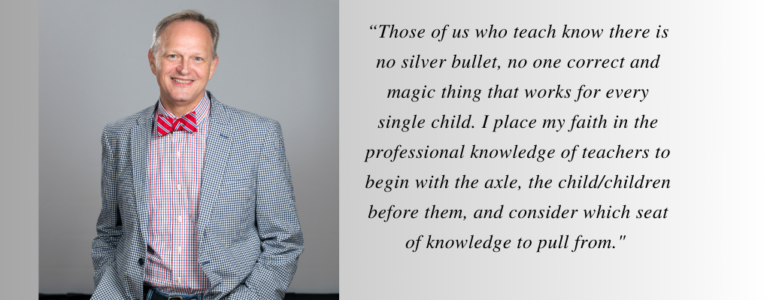By Lester Laminack
As I write this, I am beginning my forty-seventh year as an educator. I’ve been a classroom teacher, a reading teacher, a university professor, and continue now as a full-time writer and consultant working with schools throughout the US and abroad. In my career I have been witness to big shifts in how we approach the teaching of reading several times. Each time it happens there are comments about a pendulum swinging from one side to the other, from point A to point B.
It can’t be a pendulum, though. If it were a pendulum, we are simply moving from what we used to do (A) to what we’re doing (B), which is what we used to do (B) before we did what we used to do (A). If this is the case, we’ve just been moving back and forth between the same two things, which would make all of us rather silly. There would be no evolution of thinking. There would be no change in our practice. It would just be moving between A and B, constantly bickering about which is better. Therefore, I reject the notion of a pendulum.
I prefer to think of it more like a Ferris wheel. Pause a moment and picture a Ferris wheel someplace in an amusement park; it’s a giant wheel, a circle. Think about the profile of this wheel laid out like the face of a clock. There are major positions 12, 3, 6, 9, with all the smaller hash marks representing each minute between. And each one of those is a seat on the Ferris wheel which is slowly moving in a constant clockwise motion. There is always one seat in the 12 o’clock position for a while. One seat will be in the three o’clock position for a while, and another in the six o’clock position, and another in the nine o’clock position.
Using this analogy, I would argue that the seat in the twelve o’clock position is the new “it” thing getting all the public attention. It’s the current “new best way” to do something. The seat in the three o’clock position is the former “best way” of doing something and is gradually falling out of favor. The seat in the six o’clock position, which once was in the twelve o’clock position is now rejected. And, in the nine o’clock position, there is something that is being researched, retooled, tweaked, reorganized and is slowly on the rise. If you’ve been around long enough, you’ve watched that Ferris wheel make full turns, which seem to take about ten years per rotation.
As a profession we understand that how we teach, what we teach, what we think about should be, like any other professional practice, ever evolving, ever-changing as we continue to question and research and refine.
The Ferris wheel turns and the seat at twelve o’clock will rotate to three o’clock, on to six, then to nine, and eventually back around to the twelve o’clock position. But when it returns to twelve, it will not be the same as when it was previously in the twelve o’clock position. It will have been reexamined, researched, revised, revisited. It will have had time to examine what was argued against it, what was put forth as it flaws. During the movement it will fine tune, refine, repackage, reposition.
I am drawn to the idea of the Ferris wheel because that circle is always evolving. Every single seat is attached to a common axle by a spoke. If this analogy works for you, ask fifteen different people what the axle represents. I suspect you’ll get a variety of answers. From my perspective (and I’m creating the analogy) the axle is students. Every seat is connected to that axle. I believe that no matter which seat you choose on that Ferris wheel, the occupants hold the fervent belief that what they are advocating is the best thing for kids. Each seat will pull a body of research, a set of practices, a set of materials to the forefront and say, “If you just do this, it will be best for kids.”
Perhaps, if we stand back, if we move out to the edge of the fairgrounds and look at the Ferris wheel, we will see it as a unified thing rather than a collection of isolated seats. Each seat contributes to the whole and every seat is an integral part connected to one common axle.
Those of us who teach know there is no silver bullet, no one correct and magic thing that works for every single child. I place my faith in the professional knowledge of teachers to begin with the axle, the child/children before them, and consider which seat of knowledge to pull from. I trust the professional practices of teachers to weigh the needs of the student against their knowledge base and make an informed and professional decision about how to proceed. I trust professional teachers to monitor the progress and adjust those decisions as needed.
Rather than arguing over which seat holds the “right” set of practices, let’s work together to provide teachers with the most robust knowledge base possible and trust them to teach.
For more in-depth discussion and sample lessons, see Critical Comprehension: Lessons for Guiding Students to Deeper Meaning Katie Kelly, Lester Laminack, and Vivian Vasquez (2023) Corwin.
![]()













